

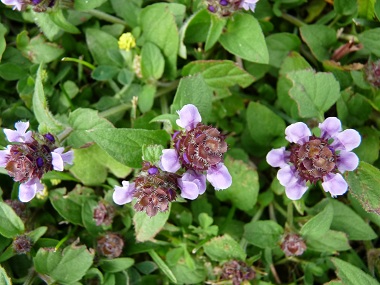
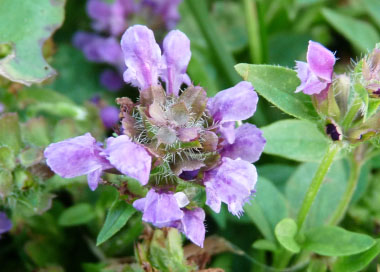
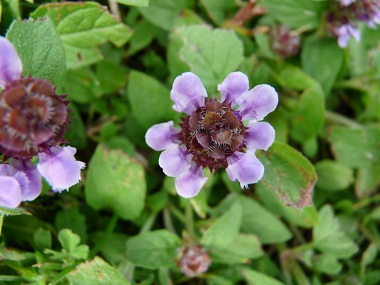
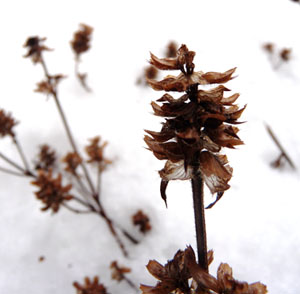
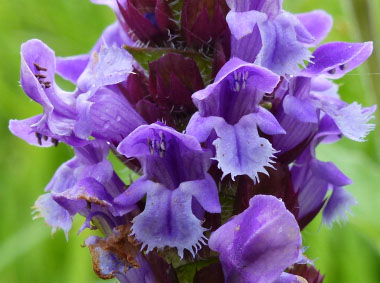
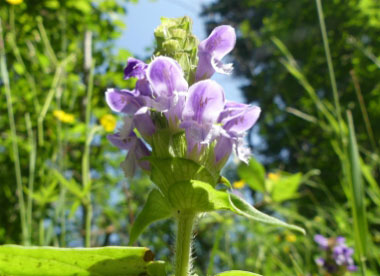
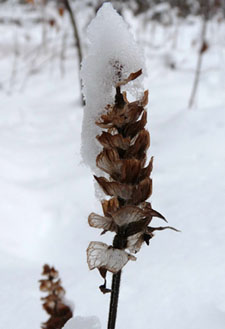
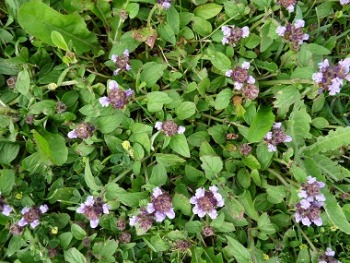
To support our efforts please browse our store (books with health benefits, etc.).
Self-heal is a useful, tenacious and edible plant that loves lawns. It tends to stay low to the ground to avoid mowing, and attracts bees and butterflies when flowering. As the name suggests, it was once a sought-after medicinal herb by herbalists and country folk alike. It was once used to help treat a variety of health ailments.
Distinguishing Features
Self-heal is a perennial plant with a solitary or clustered upright stem. Typically this plant grows 10 to 50 cm in height although some native varieties may grow taller. It is a fibrous-rooted plant from a root crown or short rhizome that thrives in loamy soil with high organic content. It especially prefers damp soils, yet can tolerate some drought conditions. An olive green dye is obtained from the stems and flowers.
Flowers
Each tubular flower is about 1 cm long and divided into two lips. The upper lip is light purple and functions as a hood, while the lower lip is whitish and fringed. The lower lip also has two lateral lobes that are smaller and light purple. The calyx is light green or reddish and quite hairy along the edges. There is no noticeable floral scent. The self-heal flower generally blooms from mid to late summer and lasts up to two months. Each flower produces four tiny seeds, which are located in the calyx.
 Fields
of Nutrition has medicinal benefits and vitamin/mineral content of Self Heal.
Fields
of Nutrition has medicinal benefits and vitamin/mineral content of Self Heal.
Leaves
Self-heal leaves are opposite and can grow up to 5 cm long and 2 cm across depending on conditions. They are broadly lanceolate or ovate, with short petioles, and have scattered white hairs along the central vein on the undersides. The leave’s margins can be smooth or have scattered blunt teeth.
Height
Most plants grow to a height of between 10 cm and 50 cm. Depending on various circumstances, some may grow to a height of 60 cm to 70 cm.
Habitat
Self-Heal grows in many countries around the world and it loves disturbed areas. Habitats include moist to mesic black soil prairies, alongside rivers and lakes, meadows, thickets, forest openings, woodland borders, pastures, and abandoned fields. Self-Heal that is common in lawns is suspected to be a Eurasian variety. This means it is shorter and it has roots at the nodes of the leaves.
Edible Parts
This wild plant is both edible and medicinal. The leaves and flowers contain high levels of antioxidants (which prevent cancer and heart disease). It has been used for centuries as medicine. Raw self-heal leaves are edible, suitable as a pot herb and have a subtle bitter taste. Although they taste better cooked, a lot of the nutrients are lost (as they are in vegetables as well) in this process. Toss leaves onto a salad, in a soup or stew or once you have mashed potatoes, add them to this. A cold water infusion of freshly chopped (or dried) leaves makes a nourishing drink. (Boil water to make tea as well.) This is an edible plant that can help many health ailments.
Other Name
Heal All.
Winter Survival Food Handbook

PDF Plant Magazines
Types of Wild Food
Geographic Zones Seasons
Disclaimer
EdibleWildFood.com is informational in nature. While we strive to be 100% accurate, it is solely up to the reader to ensure proper plant identification. Some wild plants are poisonous or can have serious adverse health effects.
We are not health professionals, medical doctors, nor are we nutritionists. It is up to the reader to verify nutritional information and health benefits with qualified professionals for all edible plants listed in this web site. Please click here for more information.
Why Edible Wild Food?
- Food costs are rising
- Free, wild food is readily abundant
- Wild food adds nutrition to your diet
- Wild food can help treat various medical conditions





